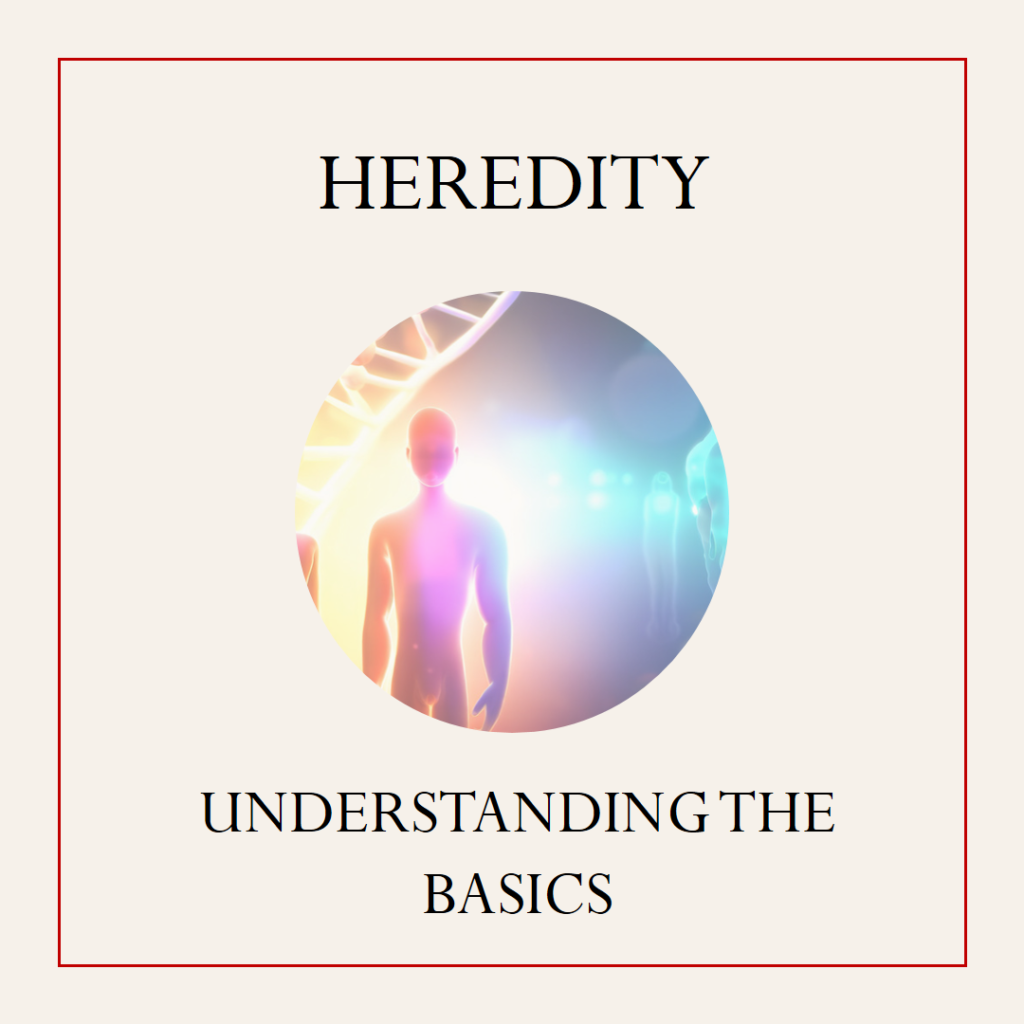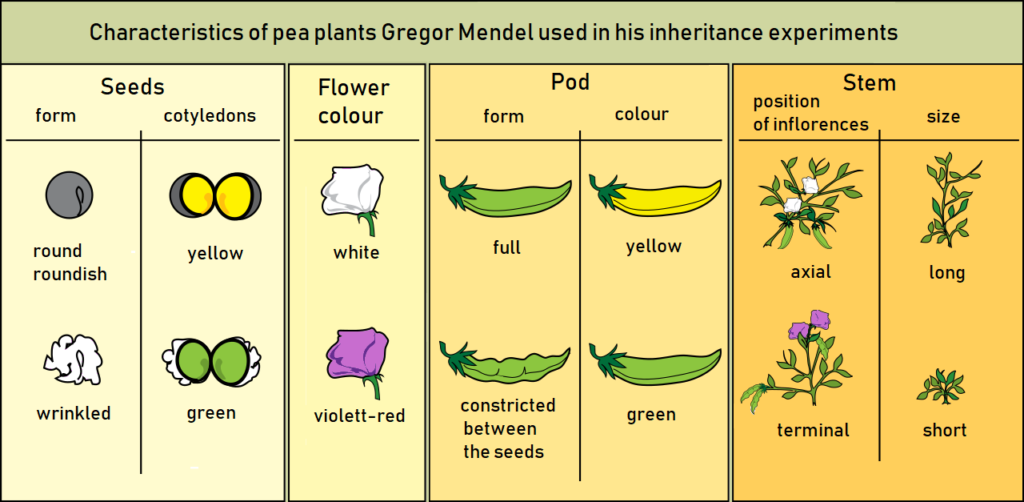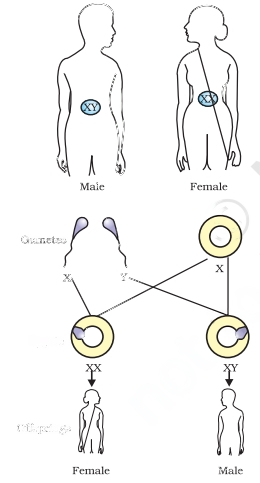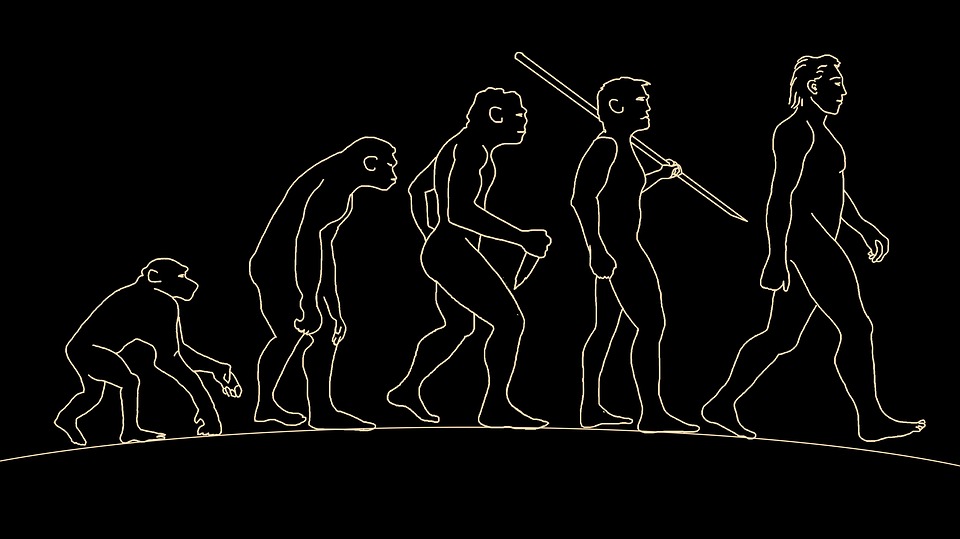Tag: class 10 biology chapter 4 heredity and evolution notes
Class 10th Heredity and Evolution Notes: NCERT Science Ch. 8
In this chapter “class 10th heredity and evolution notes“, we delve into the fascinating world of heredity and evolution. Heredity involves the transfer of characteristics from one generation to the next. While evolution encompasses the gradual progression from simple life forms to more complex organisms over multiple generations.
Here in class 10th heredity and evolution notes, we explore the mechanisms behind the creation of variations. Also, how the accumulation of these variations ultimately drives the process of evolution. Get ready to unravel the mysteries of life’s continuity and transformation.
Class 10th heredity and evolution notes of NCERT Science Ch. 8

A cross that involves the consideration of only one character between two organisms is referred to as a monohybrid cross. The resulting ratio of characters in the F2 generation is known as the monohybrid ratio.
For example, when a tall plant (TT) is crossed with a dwarf plant (tt), the F2 generation yields a ratio of 3 tall plants to 1 short plant, which represents the monohybrid ratio of 3:1. In this cross, only the height of the plants is taken into account at a time, illustrating the principles of monohybrid inheritance.
Notes for Class 10th Chapter Heredity and Evolution
Dihybrid cross
A cross that involves the consideration of two characters between two organisms is termed a dihybrid cross. The resulting ratio of characters in the F2 generation is referred to as the dihybrid ratio.

For example, if a plant with round and green peas is crossed with a plant having wrinkled and yellow peas, the first-generation plants would all exhibit round and green peas. In the subsequent F2 generation cross, we would observe four combinations of characters in the ratio of 9:3:3:1.
Thus, the dihybrid ratio is represented as 9:3:3:1. IT is indicating the occurrence of different combinations of traits resulting from the dihybrid cross between the two organisms.
Inheritance
In Biology, inheritance refers to the transmission of traits from one generation to the next.
Laws of Mendel as define in Heredity and Evolution class 10th

The Law of Dominance states that a gene possesses two contrasting alleles, and one of them always expresses itself in the organism. This allele is known as the dominant gene, and it can manifest in any possible combination.
According to the Law of Segregation, traits are completely separated during gamete formation, with no mixing of alleles. Each gamete carries only one allele for a particular trait.
The Law of Independent Assortment reveals that traits can segregate independently of different characters during gamete formation. This means that the inheritance of one trait does not influence the inheritance of another trait. It is allowing for diverse combinations of traits in offspring.
Class 10th Heredity and Evolution Notes
Sex Determination

Sex determination is the process of identifying an individual’s sex based on their genetic material composition. In various animals, the sex of an embryo is determined by diverse factors. In humans, sex determination occurs through the presence or absence of the Y chromosome.
A female human is represented by XX chromosomes, while a male is represented by XY chromosomes. An ovum always carries an X chromosome. When the ovum fuses with a sperm carrying a Y chromosome, it results in the birth of a male child. On the other hand, when it fuses with a sperm carrying an X chromosome, it leads to the birth of a female child.
This process of sex determination plays a vital role in defining an individual’s gender. It is governed by specific genetic factors that shape human development and reproduction.
What is Traits in Class 10th Heredity and Evolution
Traits are distinguishing characteristics of an organism, evident either in its visible physical form or in its physiological aspects.
Acquired Characters
Acquired characteristics refer to the traits acquired by an organism during its lifetime. However, these characteristics are not transmitted to the DNA of germ cells and, consequently, are not inherited by the next generation. For instance, traits like muscle loss and reduced weight due to starvation, loss of limbs or tails from injuries, and similar acquired features are not passed on to future generations.
Class 10th Heredity and Evolution Notes
Inherited Characters
Inherited characters refer to the traits passed down from parents to their offspring. These traits are consistently transmitted to the next generation, but their expression depends on whether they are dominant or recessive.
For instance, characteristics like height, skin color, and eye color are examples of inherited traits. While they are reliably inherited, their manifestation in the offspring can vary based on whether the alleles governing these traits are dominant or recessive. The interplay of dominant and recessive alleles determines the observable expression of these inherited characters in the offspring.
Variation
Variation represents the extent of dissimilarity among individuals within the same species. Offspring are not identical to their parents, exhibiting distinct variations. Each member of a population differs from others due to the influence of recombination and mutation. Which serve as the primary causes of these variations.
Sexually reproducing organisms display considerable diversity among individuals of a species, and the long-term accumulation of variations plays a pivotal role in the process of evolution. Environmental factors play a crucial part in evolutionary processes as they select advantageous variants, driving the progression of evolution.
Genetic Variations
Genetic variations refer to the dissimilarities in DNA sequences among organisms, contributing to the diverse gene pool. These variations result in distinct physical characteristics or biochemical pathways, showcasing the unique traits exhibited by each individual.
Natural Selection
Natural selection is the process through which a favorable trait within a species’ population is chosen. Changing environmental conditions exert equal pressure on all existing species. The species or organisms that demonstrate better adaptation to the altering conditions survive and reproduce, signifying their selection by nature.
Conversely, species or organisms that struggle to adapt face elimination, being rejected by nature. Natural selection thus acts as a driving force, shaping the survival and evolution of species in response to dynamic environmental changes.
Class 10th Heredity and Evolution Notes
Speciation
Genetic Drift
In the determination of traits that endure within a population, natural selection assumes a significant role. Nevertheless, random fluctuations in gene variants can be observed on various occasions, which is termed genetic drift. Genetic drift denotes a change in the frequency of an existing allele within a small population.
As a consequence of genetic drift, a gene variant may diminish and eventually disappear from the population, leading to a reduction in genetic variation. This phenomenon highlights the influence of chance events on the genetic makeup of small populations, and it has implications for the evolutionary trajectory of species over time.
Speciation
Speciation is the transformative process through which new species emerge from existing ones, driven by various evolutionary forces such as genetic drift, population isolation, and natural selection. This intricate process gives rise to diversity within ecosystems, and this diversity, in turn, fuels the continued evolution of life forms.
As species adapt to their unique environments and encounter diverse ecological challenges, they undergo changes that set them apart from their ancestral populations. Over time, these modifications accumulate, leading to the formation of distinct species with specialized characteristics. The diverse array of species contributes to the complexity and richness of ecosystems, driving the ongoing process of evolution and perpetuating the fascinating tapestry of life on Earth.
Gene Flow: Class 10th Heredity and Evolution Notes
Gene flow involves the movement of genes from one population to another, often facilitated by migration or the introduction of organisms to new populations. As genes are transferred between populations, the frequencies of certain genes change, leading to alterations in the genetic makeup of the receiving population.
This dynamic process of gene flow helps in the exchange and dissemination of genetic traits among different groups, contributing to genetic diversity and evolution within and across species.
Population
A population refers to a community or a collective of animals, plants, or any living organism capable of reproducing with one another and producing fertile, viable offspring.
Charles Darwin
Charles Darwin, renowned as the “Father of Evolution,” was an English naturalist and biologist. His groundbreaking theory of evolution was shaped during a five-year expedition aboard the HMS Beagle to the Galapagos Islands. This remarkable journey provided him with invaluable insights into the diversity of life and the processes of adaptation and natural selection.
In 1859, Darwin unveiled his comprehensive theory of evolution in his influential book titled “On the Origin of Species.” In this seminal work, he expounded on the concept of natural selection and its role in shaping the development and diversity of species over time. Darwin’s pioneering contributions revolutionized the field of biology and laid the foundation for our modern understanding of the evolutionary processes that govern life on Earth.
Evolution and Fossils
Evolution represents a measurable transformation in the heritable traits of a population across multiple generations. These alterations can lead to the emergence of a new species or enable existing species to adapt and thrive in their environment more effectively.
Class 10th Heredity and Evolution Notes on Origin of Species
Following a fruitful expedition aboard HMS Beagle, Charles Darwin penned a book detailing his observations from the Galapagos Islands. Titled ‘The Origin of Species,’ the book presented a comprehensive theory of evolution, primarily founded on the concept of Natural Selection.
Origin of Life – Haldane’s Theory
JBS Haldane, a distinguished British scientist, postulated the idea that life originated from organic and lifeless matter. This hypothesis was later substantiated by Urey and Miller’s experiment, confirming the validity of his theory, which became known as the theory of abiogenesis.
Evolutionary Evidence – Fossils
Numerous pieces of evidence strongly support the theory of evolution, with fossils being among the most compelling. Fossils are the well-preserved remnants of ancient animals or plants that existed millions of years ago.
These remarkable relics provide invaluable insights into the anatomy and physiology of these organisms, enabling us to comprehend the mechanisms of evolution and how they culminated in the development of the diverse life forms we encounter today.
Fossils serve as crucial time capsules, shedding light on the fascinating history of life on Earth and bolstering our understanding of the gradual transformation and diversification of species over time.
Formation of Fossils
Fossils play a crucial role in providing evidence for evolution and are created through the following steps:
1. Organisms perish and become buried in mud and silt.
2. Soft tissues decompose rapidly, leaving behind the durable bones or shells.
3. Over time, sediment accumulates and solidifies into rock.
4. As the bones decay, minerals gradually infiltrate and replace the cell contents, a process known as petrification.
5. If the bones decompose entirely, they leave behind the impression or cast of the original animal, preserving its form in the fossil record.
Evolutionary Relationships: Class 10th Heredity and Evolution Notes
Studying homologous and analogous organs offers insights into the evolutionary relationships among animals.
Homologous organs exhibit similar structures but serve different functions:
– For instance, the wings of birds and the forelimbs of mammals share similar structures, but they have been modified to suit different functions.
– Similarly, the tendril of a pea plant and the spine of a barberry plant are both modified leaves, yet they perform distinct functions.
Analogous organs, on the other hand, serve similar functions but have different structures and origins:
– The wings of bats, birds, and insects, for example, are all used for flying, but their structures vary significantly.
– Likewise, the leaves of opuntia and peepal both perform photosynthesis, but while the leaves of opuntia are modified stems, the peepal leaves are typical leaves.
Evolution by Stage
It is a gradual and extended process, unfolding over time rather than occurring abruptly. Nearly all present-day animals have undergone several stages of evolution in their journey to their current forms.
The complexities of organisms do not arise suddenly but progress incrementally, with certain traits serving limited purposes during specific stages.
This gradual progression in the evolution of species is known as “evolution by stages.” It involves a step-by-step development, where small changes accumulate over generations, leading to the emergence of new traits and characteristics.
Evolutionary transformations unfold over extended periods, encompassing numerous intermediary stages, reflecting the intricate and fascinating journey that shapes the diversity of life on Earth.
Artificial Selection
Artificial selection can lead to the evolution of multiple distinct species from a single ancestral species. A prime example is the cabbage family, where a common ancestor gave rise to several diverse species through the deliberate selection of various traits.
Through human intervention and cultivation practices, specific desirable traits were favored and perpetuated. Resulting in the emergence of distinct cabbage species with unique characteristics and adaptations. Artificial selection, driven by human influence, demonstrates the remarkable capacity to shape the course of evolution and contribute to the diversity and specialization observed in the natural world.
Molecular Phylogeny
Phylogeny refers to the evolutionary connections between various biological species, giving rise to an evolutionary tree. In molecular phylogeny, these relationships are explored at the molecular level, primarily through the examination of DNA sequences. This entails the analysis of DNA composition and gene comparisons among different species.
By studying the hereditary molecular traits, such as DNA sequences, scientists can unravel the intricate evolutionary history and relationships among diverse organisms. Molecular phylogeny offers valuable insights into the common ancestry and evolutionary divergence of species, shedding light on the dynamic and interconnected nature of life’s evolutionary journey.
Human Evolution

Human Evolution
Humans are categorized within the primate family, and their genetic connection to chimps and other primates is remarkably close. Although the full evolutionary journey from primates to humans remains a mystery, a broader understanding of human evolution has emerged.
The ancestry of humans includes various predecessors like Dryopithecus, Ramapithecus, Australopithecus, Homo erectus, Homo sapiens neanderthalensis, Cro-magnon man, and ultimately, Homo sapiens – us.
The study of these ancestors and their characteristics provides valuable insights into the fascinating path of human evolution. While some aspects of our evolutionary history may remain elusive, the evidence gathered from these ancestral relatives paints a vivid picture of the transformation that led to the emergence of modern humans.
Read Also:
- Class 10 Notes for Science NCERT
- Chemical Reaction and Equation Notes Class 10 NCERT Sci. Ch.1
- Acids Bases and Salts Class 10 Notes of NCERT Science Ch. 2
- Metals and Non Metals Class 10 NCERT Science Chapter 3 Notes
- Life Process Notes Class 10 NCERT Science Chapter 5
- Control and Coordination Notes Class 10: NCERT Science Ch. 6
- Class 10th How Do Organisms Reproduce Notes: Science Ch. 7
- Class 10th Heredity and Evolution Notes: NCERT Science Ch. 8
- Notes on Magnetic Effect of Electric Current Class 10 NCERT
- Human Eye and the Colourful World Notes Chapter 10 Science
- Class 10th Chapter 11 Science Notes for NCERT Students
- Notes of Our Environment Class 10: NCERT Science Chapter 13
Frequently Asked Questions on Class 10th Heredity and Evolution Notes
Q 1. what are the sources of genetic diversity within a population?
The sources of genetic diversity within a population include mutations, which introduce new variations in the DNA sequence. Genetic recombination during sexual reproduction, creating unique combinations of alleles. Gene flow, through migration or interbreeding, brings in new genes from other populations. Natural selection favors advantageous traits, increasing their frequency, while genetic drift, in small populations, causes random changes in gene frequencies. These processes collectively contribute to the variability of traits in a population, enabling adaptation to changing environments and promoting species survival and evolution.
Q 2. From Class 10th Heredity and Evolution Notes How you can explain the evolution diversity of life on Earth?
The Evolution explains the diversity of life on Earth through the gradual process of genetic change and natural selection. Over millions of years, genetic variations arise within populations due to mutations and genetic recombination during reproduction. Natural selection then acts on these variations, favoring advantageous traits that increase an organism’s chances of survival and reproduction in specific environments. As a result, organisms with beneficial traits pass on their genes to future generations, leading to the accumulation of adaptive characteristics and the diversification of species. This continuous process of genetic change and selection has resulted in the vast array of life forms and their adaptations to different ecological niches on Earth.
Q 3. What is the role of adaptation in the survival and success of organisms in various environments?
Adaptation plays a crucial role in the survival and success of organisms in various environments. It refers to the process by which organisms develop advantageous traits that enable them to better suit their surroundings. Organisms with beneficial adaptations have increased chances of survival, reproduction, and passing on their advantageous genes to the next generation. In different environments, such as extreme temperatures, limited resources, or predators, adaptations can provide a competitive advantage. Over time, these advantageous traits become more prevalent in the population, leading to the specialization and diversification of species, ultimately enhancing their ability to thrive and persist in their respective habitats.
Q 4. What is the significance of studying heredity and evolution in fields like medicine and agriculture?
Studying heredity and evolution holds immense significance in fields like medicine and agriculture. In medicine, understanding heredity helps identify genetic factors responsible for various diseases, enabling personalized treatments and genetic counseling. Knowledge of evolution aids in comprehending the origin of diseases and their potential spread. In agriculture, studying heredity assists in breeding programs to develop crops with desired traits, such as higher yield or resistance to pests and diseases. Understanding evolutionary principles aids in combating evolving pests and diseases, improving crop resilience, and developing sustainable agricultural practices. Both fields benefit from the insights gained through the study of heredity and evolution, leading to advancements and better strategies for human health and food security.
Q 5. What is heredity, and how does it influence the transmission of traits from one generation to another?
Heredity is the process by which traits or characteristics are passed from parents to their offspring through genetic information encoded in DNA. It influences the transmission of traits from one generation to another by the inheritance of genes. Offspring inherit a combination of genes from their parents, determining their physical and biochemical traits. Genes come in different forms called alleles. The combination of alleles inherited from each parent influences the expression of traits in the offspring. Some traits may be dominant, and their alleles are expressed over recessive traits. Heredity ensures continuity and variation in populations, allowing the transfer of genetic information and shaping the diversity of life on Earth.